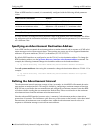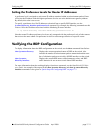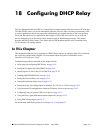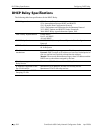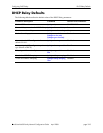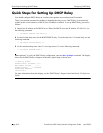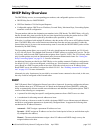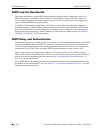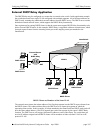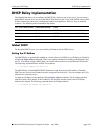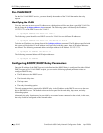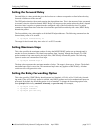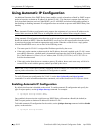
Configuring DHCP Relay DHCP Relay Overview
OmniSwitch 6600 Family Network Configuration Guide April 2006 page 18-5
DHCP Relay Overview
The DHCP Relay service, its corresponding port numbers, and configurable options are as follows:
• DHCP Relay Service: BOOTP/DHCP
• UDP Port Numbers 67/68 for Request/Response
• Configurable options: DHCP server IP address, Forward Delay, Maximum Hops, Forwarding Option,
automatic switch IP configuration
The port numbers indicate the destination port numbers in the UDP header. The DHCP Relay will verify
that the forward delay time (specified by the user) has elapsed before sending the packet down to UDP
with the destination IP address replaced by the address (also specified by the user).
If the relay is configured with multiple IP addresses, then the packet will be sent to all IP address destina-
tions. The DHCP Relay also verifies that the maximum hop count has not been exceeded. If either the
forward delay time is not met or the maximum hop count is exceeded, the BOOTP/DHCP packet will be
discarded by the DHCP Relay.
The forwarding option allows you to specify if the relay should operate in the standard, per-VLAN only,
or AVLAN-only mode. The standard mode forwards all DHCP packets on a global relay service. The per-
VLAN only mode forwards DHCP packets that originate from a specific VLAN. The AVLAN-only mode
only forwards packets received on authenticated ports from non-authenticated clients. See “Setting the
Relay Forwarding Option” on page 18-11 for more information.
An additional function provided by the DHCP Relay service enables automatic IP address configuration
for default VLAN 1 when an unconfigured switch boots up. If this function is enabled, the switch broad-
casts a BootP or a DHCP request packet at boot time. When the switch receives an IP address from a
BootP/DHCP server, the address is assigned to default VLAN 1. See “Enabling Automatic IP Configura-
tion” on page 18-12 for more information.
Alternately the relay function may be provided by an external router connected to the switch; in this case,
the relay would be configured on the external router.
DHCP
DHCP (Dynamic Host Configuration Protocol) provides a framework for passing configuration informa-
tion to Internet hosts on a TCP/IP network. It is based on the Bootstrap Protocol (BOOTP), adding the
ability to automatically allocate reusable network addresses and additional configuration options. DHCP
consists of the following two components:
• A protocol for delivering host-specific configuration parameters from a DHCP server to a host.
• A mechanism for allocating network addresses to hosts.
DHCP is built on a client-server model in which a designated DHCP server allocates network addresses
and delivers configuration parameters to dynamically configured hosts. It supports the following three
mechanisms for IP address allocation.
Automatic—DHCP assigns a permanent IP address to a host.
Dynamic—DHCP assigns an IP address to a host for a limited period of time (or until the host explic-
itly relinquishes the address).
Manual—The network administrator assigns a host’s IP address and DHCP simply conveys the
assigned address to the host.



